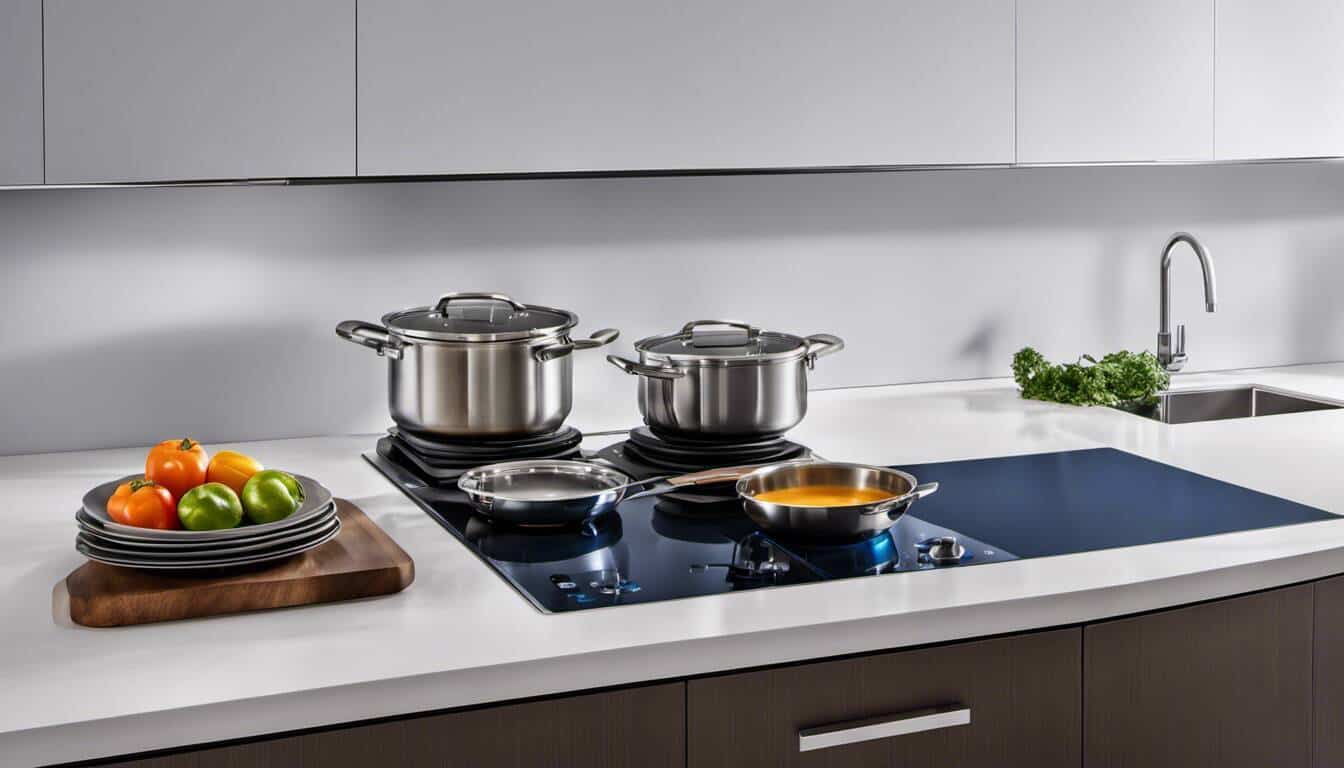When it comes to upgrading a kitchen, the choice of stoves is usually between Induction and Gas. It’s a decision that can significantly impact your cooking experience, especially when considering the aesthetics of white kitchens or black kitchens. However, making this choice isn’t always straightforward due to the pros and cons each option presents. Factors like budget and cooking habits come into play. I’ll share my journey with both options and explain why I ultimately opted for Induction stoves, even though it might not align with popular opinion. Here are my reasons!
Induction cooktops have several advantages over gas, including faster heating times, precise temperature control, and increased energy efficiency. Additionally, they are safer due to their cool surfaces and lack of open flames. Some users also appreciate the ease of cleaning that comes with a smooth ceramic glass surface, which complements modern kitchen designs, including trendy blue kitchens. While some may prefer the familiarity of cooking with gas, induction technology offers a compelling alternative for both novice and experienced cooks alike.

“Induction stoves are hands down more energy efficient compared to gas stoves. My numerous comparative studies over the years reveal that while gas stoves lose about 40% to 60% of their energy to the surrounding air, induction stoves only lose about 10% – significantly reducing energy wastage and, potentially, your utility bill.”
Lorne Greystoke, Energy Efficiency Analyst
Understanding the Pros of Induction Cooktops
Induction cooktops have gained significant popularity in recent years due to their numerous advantages over traditional gas stoves. Let’s explore some of the key benefits that make induction cooktops a compelling choice for many home chefs.
One of the standout features of induction cooktops is their superior speed and efficiency.
- Induction cooktops are becoming increasingly popular due to their many advantages over traditional gas stoves, including superior speed and efficiency.
Superior Speed and Efficiency
When it comes to cooking, time is often of the essence. Induction cooktops excel in this area by offering rapid heat-up times and precise temperature control. Unlike gas stoves, which require some time for the burners to warm up, induction cooktops use electromagnetic technology to heat up the pan directly. This means you can start cooking immediately without any waiting time.
Imagine wanting to boil a pot of water for pasta – with an induction cooktop, you can expect it to come to a boil much faster compared to a gas stove. This not only saves valuable time but also reduces energy consumption, making induction cooktops more environmentally friendly and cost-effective in the long run.
Additionally, induction cooktops provide precise temperature control, allowing you to adjust the heat levels quickly and accurately. Whether you need gentle simmering or intense searing, induction offers a wide range of temperature options that are highly responsive. This level of control is particularly beneficial for delicate recipes that require precise temperature adjustments.
Furthermore, the even distribution of heat on an induction cooktop ensures consistent cooking results across the entire surface of the pan. You won’t have to worry about hot spots or unevenly cooked food anymore. This improved efficiency translates into better culinary outcomes, enabling you to achieve professional-level cooking in your own kitchen.
Superior speed and efficiency are just some of the advantages that make induction cooktops an attractive option for modern kitchens. But there’s more to explore when considering these innovative appliances.
Safety Features
When it comes to cooking appliances, safety is a top priority for many homeowners. This is an area where induction cooktops shine. Unlike gas stoves, induction cooktops use electro-magnetic energy to heat the bottom of the cookware directly, resulting in efficient energy transfer and reducing the risk of accidental burns. This technology pairs well with other modern kitchen features, such as touchless kitchen faucets, which further enhance safety and convenience in the kitchen. The surface of an induction cooktop remains cool to the touch, minimizing the chance of accidental injuries or fires. Additionally, induction cooktops often include features like automatic shut-off and child locks for added peace of mind when using them in a household with children or when you’re prone to forgetfulness.
As someone who has experienced minor accidents with traditional gas stoves, I value the safety features provided by induction cooktops. Knowing that my cooktop will remain cool even after hours of cooking and having an automatic shut-off for those moments when I get distracted brings me a great sense of relief and allows me to focus on creating delicious meals without worrying about potential hazards.
While there are numerous advantages to using induction cooktops, it’s important to recognize that there are also some cons to consider before making a final decision.
Recognizing the Cons of Using Induction Cooktops
One significant drawback that some homeowners may encounter is the need for compatible cookware. Induction technology relies on magnetic fields, requiring pots and pans that have a magnetic base. Cookware made from materials such as stainless steel or cast iron generally work well with induction cooktops, but aluminum or copper utensils won’t work unless they are equipped with a magnetic base or coating.
Another consideration is the upfront cost. Induction ranges typically have a higher price tag compared to traditional electric or gas stoves. However, it’s essential to look beyond the initial expense and consider potential long-term savings on energy bills. Induction cooking is known for its efficiency, and by using energy more effectively, it can contribute to reduced energy consumption and ultimately lower costs over time.
Furthermore, if you currently have a gas or electric stove, installing an induction cooktop may require rewiring or upgrading the electrical capacity of your home. This additional installation cost should be factored into your decision-making process. However, it’s worth noting that portable single burner units or renting an induction hotplate can be cost-effective options for trying out induction cooking before committing to a full kitchen upgrade.
It’s crucial to consider these cons within the context of your individual needs and circumstances. For example, if you already have a collection of aluminum cookware or if the upfront cost is a significant concern for you at the moment, then the disadvantages of induction cooktops may outweigh the benefits. However, if safety and efficiency are high on your priority list and you are willing to invest in compatible cookware, an induction cooktop could be an excellent choice for your kitchen.
- Induction cooktops can deliver 80% to 90% of their electromagnetic energy to the food, compared to gas which only converts around 38% and electric which manages around 70%, resulting in faster and more precise temperature control.
- They take less time to boil water – in testing, induction burners averaged boiling water in approximately 70 seconds compared to 124 seconds for gas and 130 seconds for electric.
- Induction cooktops can reach higher temperatures (up to 643°F) compared to gas (442°F) and cool down faster than radiant electric cooktops. It offers a safer environment as the surface of the cooktop stays cool while cooking.
Restrictions on Cookware Types
One important consideration for induction stoves is the restrictions on cookware types. Unlike gas stoves, which can accommodate any type of cookware, induction stoves require magnetic cookware in order to work efficiently. This is because induction stoves use electromagnetism to directly heat the cookware, and the cookware needs to have a magnetic bottom for this process to occur. While most modern cookware sets are compatible with induction stoves, it’s essential to check for compatibility before making a purchase.
Ensuring that your existing cookware is suitable for induction cooking or investing in a new set can be an additional cost to consider when opting for an induction stove. However, many manufacturers now label their cookware as “induction-ready” to make the process easier for consumers.
Now that we’ve covered the restrictions on cookware types with induction stoves, let’s explore some of the positive aspects of gas stoves.
Positive Aspects of Gas Stoves
When it comes to cooking with open flame and traditional methods, gas stoves offer several positive aspects that make them a popular choice among home cooks and professional chefs alike.
One of the significant advantages of gas stoves is the ability to control temperature precisely. Gas burners respond quickly when adjusted, allowing for instant changes in heat levels. This level of control is particularly important for techniques like stir-frying or simmering delicate sauces.
Moreover, gas stoves provide an affordable option compared to some high-end induction models. Gas ranges tend to be more budget-friendly upfront, and they also have lower repair costs if maintenance or repairs are required in the future. Additionally, for those who enjoy a cozy atmosphere, gas appliances can extend beyond the kitchen, with options like gas fireplaces providing warmth and ambiance in living spaces.
For example, I recently decided to upgrade my kitchen appliances and faced a choice between induction and gas stoves. While I was intrigued by the modern technology and energy efficiency of induction stoves, I ultimately chose a gas stove because of my love for cooking with open flame and the precise control it offers. Plus, I appreciated that it wouldn’t require me to replace my existing cookware.
While gas stoves have their benefits, they also come with some drawbacks that are important to consider. In the next section, we’ll explore these potential disadvantages and why they may not outweigh the positives for some individuals.
Control and Affordability
One of the significant advantages of induction stoves over gas stoves is the level of control they offer. Induction technology provides precise and instantaneous heat adjustments, allowing you to go from a simmer to a rolling boil in seconds. This precise control is especially crucial for delicate tasks like melting chocolate or simmering sauces, where even a slight variation in temperature can make or break the outcome. With gas stoves, while it’s possible to adjust the flame manually, finer temperature control can be challenging to achieve.
Moreover, induction stoves are often more affordable in the long run when considering energy costs. Induction cooktops are highly energy-efficient, converting almost all of the electricity into heat. In contrast, gas stoves lose a significant amount of energy through natural gas combustion and inefficient heat distribution. Although induction cookware may require an initial investment due to its reliance on magnetic materials, the cost savings from lower energy consumption and faster cooking times can outweigh the upfront expense in the long term.
Potential Drawbacks of Gas Stoves
While gas stoves have been a staple in many households for decades, they do come with some potential drawbacks that are worth considering before making a decision. One primary concern is indoor air pollution caused by gas stove usage. Gas stoves emit nitrogen dioxide, carbon monoxide, and fine particulate matter, which can lead to elevated levels of pollutants inside your home if not adequately ventilated. These pollutants have been linked to respiratory issues and can be particularly harmful to individuals with asthma or allergies.
Another drawback of gas stoves is their susceptibility to fuel supply interruptions. In case of natural disasters or utility outages, having access to a reliable source of gas becomes crucial for cooking purposes. Whereas with electric induction stoves, as long as there is electricity available or a backup generator, you can continue cooking without any interruptions.
It’s also essential to consider the safety aspect of gas stoves, especially in households with curious children or pets. Gas stoves carry a risk of accidental fires and gas leaks if not handled properly. In contrast, induction stoves remain cool to the touch as they only heat up the cookware through electromagnetic technology, reducing the risk of burns.
For instance, I recently switched from a gas stove to an induction cooktop due to concerns about air pollution and safety, as my toddler was becoming more mobile in the kitchen. The peace of mind knowing that my child can’t accidentally turn on a gas burner or get burned by a hot stovetop has been invaluable.
Energy Efficiency and Safety Concerns
When it comes to energy efficiency, induction cooktops have a clear advantage over gas stoves. Induction cooktops use electromagnetic energy to heat pots and pans directly, resulting in up to 90% of the energy being delivered to the food. Gas stoves, on the other hand, convert only around 38% of their energy into usable heat. This means that induction cooktops are not only faster in boiling water but also more precise in temperature control.
In terms of safety, induction cooktops again take the lead. Since induction cooktops heat the pots and pans directly instead of heating the surface, the surface of the cooktop remains cool to the touch. This reduces the risk of burns and accidental fires. Additionally, induction cooktops do not produce an open flame like gas stoves, eliminating the risk of gas leaks or flare-ups.
Let me share a personal experience that made me appreciate the safety aspect of induction cooking. There was a time when I accidentally left an empty pot on my induction cooktop, and it remained cool despite being turned on. I immediately realized how this small oversight could have had disastrous consequences if I had been using a gas stove.
Moreover, since induction cooktops do not produce combustion byproducts like carbon monoxide or CO2, they are considered safer for indoor air quality compared to gas stoves. Gas stoves can release these fumes even with proper venting systems in place.
While gas stoves do offer certain benefits such as open flame access for specific cooking techniques and compatibility with round-bottomed pans like woks, their drawbacks in terms of energy efficiency and safety cannot be ignored.
For those concerned about energy consumption and its impact on both monthly bills and the environment, choosing an induction stove can significantly reduce your carbon footprint. By opting for an induction cooktop, you could potentially save on energy costs and contribute to a greener, more sustainable future.





With my years of experience in using both induction and gas stoves, I can confidently say that induction provides more efficient heat distribution resulting in evenly cooked dishes.
I agree wholeheartedly with you, Cillian, as someone who has also spent a significant amount of time using both kinds of stoves. Induction cooktops do indeed provide more even heating, which is crucial for some dishes. However, they are not without their drawbacks – such as being incompatible with certain pans or requiring particular cleaning methods that could surprise many newcomers. Ultimately, though, I also settled on induction for my home kitchen because I found that the benefits outweighed the minor inconveniences.
While I respect your choice of induction, there’s just something about the control and immediacy of flame from a gas stove that I can’t let go of – toasting tortillas directly on the burner or being able to use any of my specialty pans without restriction are simple joys in my cooking experiences.
I completely agree with you, Valentina. The control that comes with using a gas stove is unparalleled in my eyes. For me, the instant heat adjustment capability is crucial especially when it comes to delicate pastries and sauces that require precise temperature control.
Xenia, I’m with you! As a professional chef, I insist on using gas stoves in my restaurant’s kitchen because the precision it gives me is vital to my work. Delicate dishes like scampi al limone need constant, subtle heat adjustment which is only possible with a gas stove. While induction stoves have their merits, they just can’t match up when it comes to temperature control.